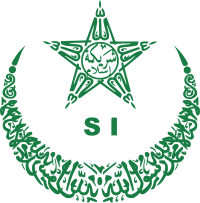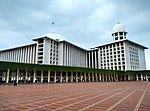
The Communist Party of Indonesia was a communist party in Indonesia. It was the largest non-ruling communist party in the world before its violent disbandment in 1965. The party had two million members in the 1955 elections, with 16 percent of the national vote and almost 30 percent of the vote in East Java. During most of the period immediately following the Indonesian Independence until the eradication of the PKI in 1965, it was a legal party operating openly in the country.

Semaun, also spelled Semaoen, was the first chairman of the Communist Party of Indonesia (PKI) and was a leader of the Semarang branch of the Sarekat Islam.
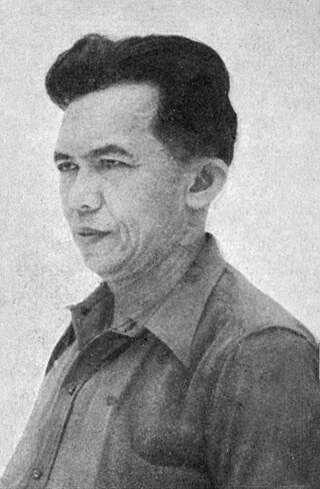
Tan Malaka was an Indonesian teacher, Marxist, philosopher, founder of Struggle Union and Murba Party, independent guerrilla and spy, Indonesian fighter, and national hero. Tempo credited him as "Father of the Republic of Indonesia".

Munawar Musso was a leader of the Communist Party of Indonesia and one of the key figures in the 1948 Madiun affair.
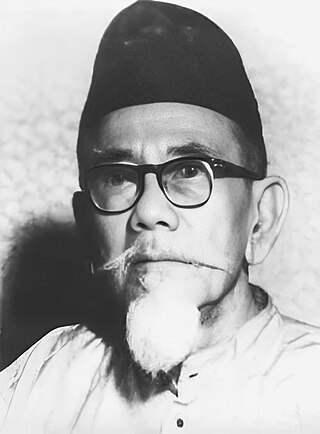
HajiAgus Salim was an Indonesian journalist, diplomat, and statesman. He served as Indonesia's Minister of Foreign Affairs between 1947 and 1949.

Oemar Said Tjokroaminoto, better known in Indonesia as H.O.S. Tjokroaminoto, was an Indonesian nationalist. He became one of the leaders of the Islamic Trade Union, founded by Samanhudi, which became Sarekat Islam, which they both cofounded.

Hadji Samanhudi was the founder of Sarekat Dagang Islam, an organization in Indonesia that previously served as an association for batik traders in Surakarta, and later broadened its scope to nationalist political issues.

The Council of Indonesian Muslim Associations Party, better known as the Masyumi Party, was a major Islamic political party in Indonesia during the Liberal Democracy Era in Indonesia. It was banned in 1960 by President Sukarno for supporting the PRRI rebellion.

Soekiman Wirjosandjojo was an Indonesian politician and physician who served as prime minister of Indonesia from 1951 until 1952. Additionally, Soekiman served as the first president of the Masyumi Party from 1945 to 1951.

Indonesian Islamic Union Party was an Islamic political party in Indonesia before and after independence. In 1973 it was merged into the United Development Party.

The Volksraad was an advisory, and later semi-legislative institution for the Dutch East Indies, provided for by law in 1916 but only established with the actual installation of the Council in 1918. It was a hesitant and slow attempt at democratisation of the Dutch East Indies as part of the "ethical policy" adopted by the Dutch government. The power of the Volksraad was limited as it only had advisory powers. Although part of the council was elected, only a small proportion of the population had voting rights.
Insulinde (1907–1919), a direct successor of the Indische Party (IP) and later renamed the Nationale Indische Party (NIP), was a political organization that represented efforts by some Indo Eurasians to identify and cooperate with the Indigenous educated élite of the Dutch East Indies in an effort to establish an independent dominion. The organisation was mainly led by Indo-European and Javanese activists, but had a considerable membership in the South Moluccas. It was considered part of the more radical political wing in the colony, for which it faced much oppression from the colonial authorities.

Tirto Adhi Soerjo was an Indonesian journalist known for his sharp criticism of the Dutch colonial government. Born to a noble Javanese family in Blora, Central Java, Tirto first studied to become a doctor but later focused on journalism. A freelancer since 1894, in 1902 he was made an editor of the Batavia based Pembrita Betawi. Tirto established his first newspaper in 1903 and, four years later, created Medan Prijaji as a medium for educated native Indonesians. This proved his longest-lived publication, lasting over five years before Tirto was exiled in 1912 to Bacan for his staunch anti-colonial criticism.
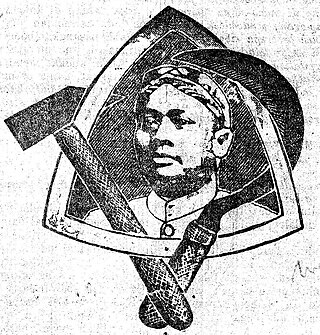
Mohammad Misbach, commonly known as Haji Misbach, was a communist and Islamic activist from Surakarta, Dutch East Indies. He was a leading member of the left wing of the Sarekat Islam organization in the 1910s and famously advocated for the compatibility of Islam and communism.
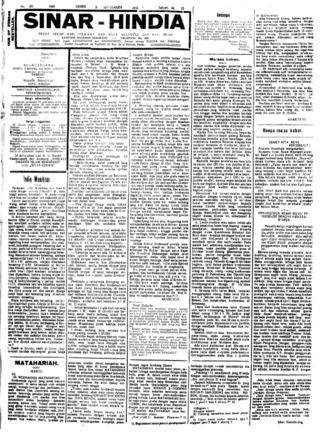
Sinar Hindia was a left-wing Malay language newspaper from Semarang, Dutch East Indies, which published from 1900 to 1924. In its later years it was the mouthpiece of the left wing of the Sarekat Islam and its editors Mas Marco Kartodikromo and Semaun were instrumental in the rise of the Communist Party of Indonesia.

Oetarjo Anwar Tjokroaminoto was an Indonesian politician and journalist. He served as Minister of Social Affairs for a year in the Wilopo Cabinet and was the Prime Minister of Pasundan for less than a month during January 1950.
Soetitah was a Sarekat Islam and Communist Party of Indonesia (PKI) propagandist, activist, and schoolteacher in Semarang, Dutch East Indies in the 1910s and 1920s. She was a close ally of Semaun, Tan Malaka, and other Semarang communists of the time and was chair of the women's section of the party in the early 1920s. She was exiled by the Dutch to the Boven-Digoel concentration camp from 1927 to 1930.
Moenasiah was a Sarekat Islam and Indonesian Communist Party leader active in Semarang, Central Java, Dutch East Indies during the 1920s. She was chairperson of the women's section of the Communist Party for a time in the 1920s. She was exiled by Dutch authorities to Boven-Digoel concentration camp from 1927 to 1930.

Hausman Baboe was a colonial head of Kuala Kapuas district of Central Kalimantan in the Dutch East Indies; he was also an early Dayak journalist and an Indonesian nationalist. Baboe was born into an aristocratic family of Dayak Ngaju people and served as head of Kuala Kapuas under the Dutch colonial government but was dismissed from his post due to his anti-colonial remarks. He became a prominent Dayak political figure and was several times accused of being a communist due to his close association with the left-wing political party Sarekat Rakjat. Despite being a Christian, his Indonesian nationalist ideals drew him close to Sarekat Islam.
The Indonesian Islamic Party was an Islamic political party in the Dutch East Indies. Formed by dissenting members of the Indonesian Islamic Union Party (PSII) in 1938, the party was dissolved by the occupying Japanese in March 1942.
